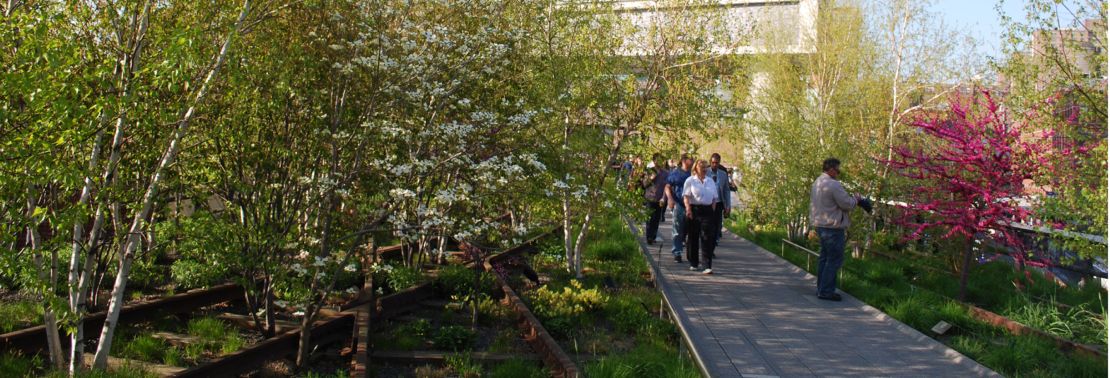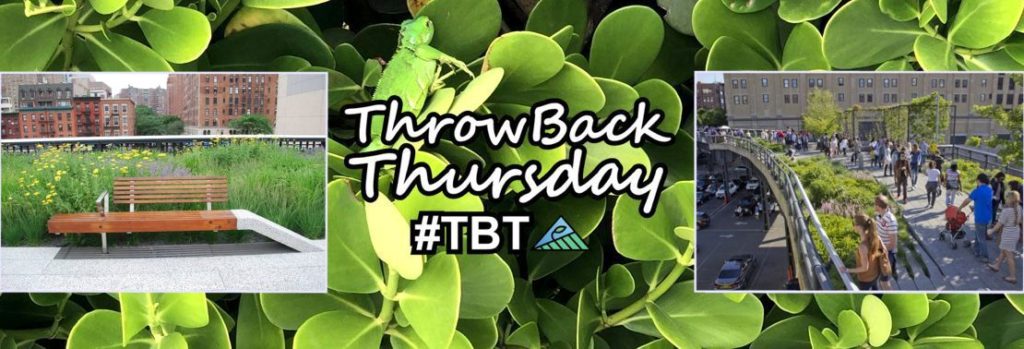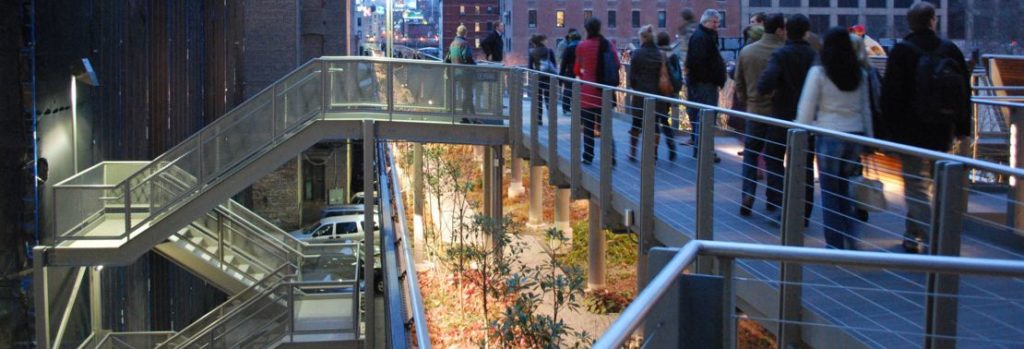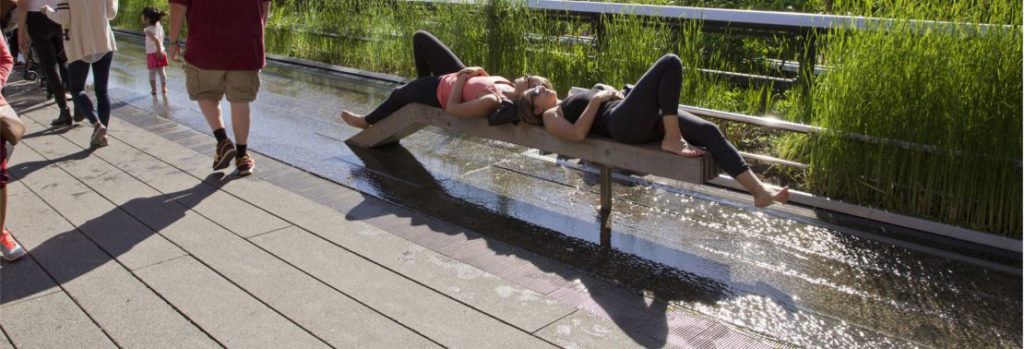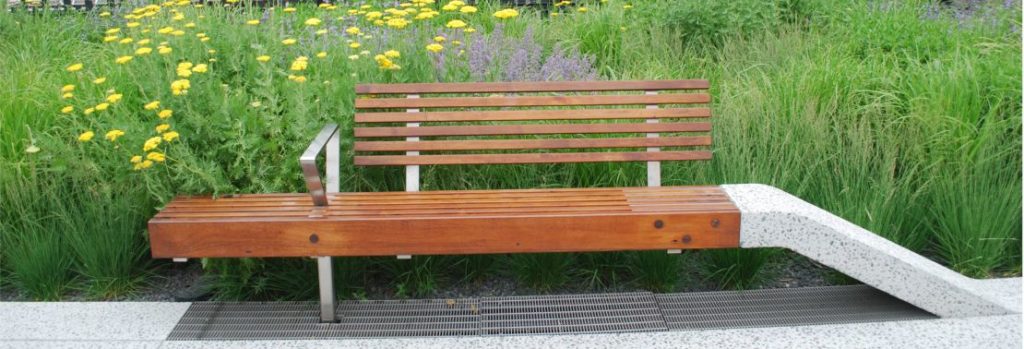A Comparison of the Three Phases of the High Line, New York City: A Landscape Architect and Photographer’s Perspective
“A Comparison of the Three Phases of the High Line, New York City: A Landscape Architect and Photographer’s Perspective” compares Phase One with Phase Two, and describes what is proposed for Phase Three. Design features to be reviewed include the walk system, seat furnishings, plantings, signage and graphics, water feature and drinking fountains, public art, lighting, maintenance and irrigation, and Phase 3. The author also offers suggestions on economic impacts, restrictions and user activities, sustainability, and studies/research.
Originally, due to the length and photo essay nature of the contribution, the series was presented approximately every few weeks in 14 parts between 2013 and 2015; to ensure background information, the Series Introduction is repeated on all.
Part 11 – Restrictions and User Activities & Sustainability
By Steven L. Cantor, Landscape Architect – Originally Posted August 28, 2014
All Photos © Steven L. Cantor
Series Introduction

Phase One High Line on July 15, 2009.
Designed by landscape architect James Corner of Field Operations, architect Ricardo Scofidio of Diller Scofidio + Renfro with planting design by Piet Oudolf, the High Line, the remarkable linear park built on an abandoned railroad viaduct in New York City, has been enormously popular.
The design team anticipated how well green roof technology would function and adapt to the viaduct since it could handle at once the huge weight of several fully-loaded trains carrying heavy tonnage. As an intensive green roof, it has very few structural load limits which would curtail use. At peak use times there can be lines of pedestrians waiting to enter with as many as 20,000 visitors per day on weekends.[1]
The High Line has won numerous awards, and in particular several as a green roof, for example, in 2013 and 2010 from the American Society of Landscape Architects, Green Roofs for Healthy Cities in 2011, and in 2010 from the International Green Roof Association. This is a rare public project in which the success of the initial phase contributed to a high level of funding for subsequent phases.
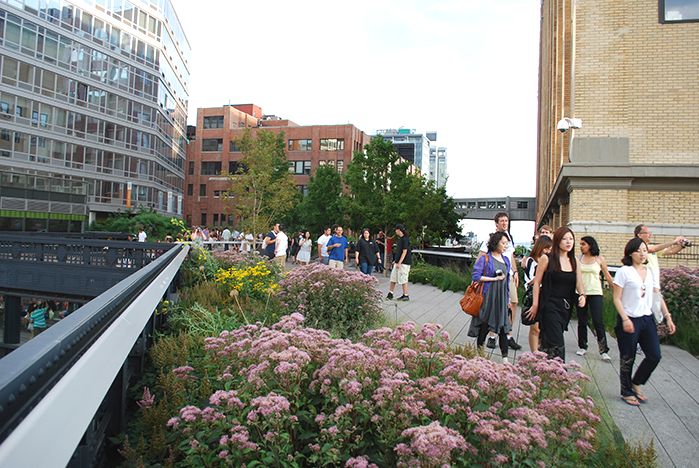
7.16.11.
The High Line has benefited from intense scrutiny as a result of lectures in which the designers were questioned; public hearings, media critiques in newspapers, journals, and blogs; lobbying from specific organizations, such as the Rainforest Coalition; and comments from city government and other public officials.
Improvements or adjustments were implemented to some design elements of the first phase, and significant modifications were done in the second phase. Are these changes aesthetic, appropriate and ethical, and are they consistent with the goals of sustainability? Is the High Line a sustainable design?
Part 11: Restrictions and User Activities Discussion
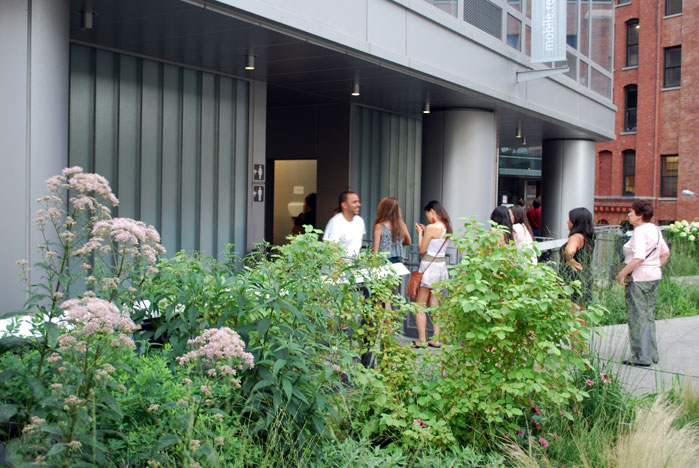
Waiting in line for the restrooms on the High Line on 6.10.11.
As the High Line has evolved, some uses have changed. When it first opened there was only one elevator, and baby carriages and strollers were rare; they are quite popular now since there are five entrances with elevators at 14th Street, 16th Street, 23rd Street, 30th Street and the newest one at the main entrance at Gansevoort Street. The elevator at W. 23rd Street was damaged by the flooding due to Storm Sandy, and it took approximately a year and a half to repair and re-open. (Read Visitor Info from the High Line website for updates and download the new free app.)
I’ve observed people with strollers laboriously hauling them up three flights of stainless steel steps, as they are not willing to walk a quarter mile to the nearest elevator. Unfortunately, there are only two sets of restrooms – the original one above 16th Street at the approximate midpoint, where there is direct access to one of the new hotels, and a newer one at the Gansevoort Street access point. So, people in need of restrooms in between must navigate back to the street level and find restrooms at other facilities, such as restaurants or hotels.
Bike racks are located every few blocks at street level. Several locations of the city’s new bike program, where participants can pick-up and return bikes at nominal fees per hour, are located near major entrances of the High Line.
To some degree the High Line self-selects for relatively healthy people, as most visitors choose to walk up the stairs to access the linear park 30 feet above street level. Joggers have learned to use the route at off peak hours.
When there is almost an unlimited budget for revisions to design details and changes to materials, it is nevertheless hard to conceive of the public art installations, the diverse array of lighting fixtures and manufacturers, the proliferation of food stands and the large number of park employees as being consistent with the spirit of sustainability so carefully and thoughtfully incorporated into much of the project, because all of these additional amenities, systems and personnel add considerably to the cost of operations and maintenance.
Dogs, except for guide dogs, are not permitted in the park, nor are bicyclists, skateboarders, scooters, skates, or alcohol (except in designated eating areas where food and drinks are sold). Amplified sound and filming or photography requiring exclusive use of an area are not permitted, except by permit. Gatherings or groups of more than 20 people require a permit. Smoking is not permitted (in 2011 a new law banned smoking in all New York City parks).
There are also more standard prohibitions against walking on rail tracks, gravel or plants; sitting or climbing on the railings; picking flowers or plants, littering and throwing objects. Finally, it is forbidden to block paths or entrances. Many of these rules can be explained due to the sheer volume of people using the park, so that this policy protects them. However, part of the justification for excluding dogs is that their “urine is highly acidic and highly dangerous to the roots of plants” and would end up in the growing beds for the plants, since all runoff is directed that way.[9]
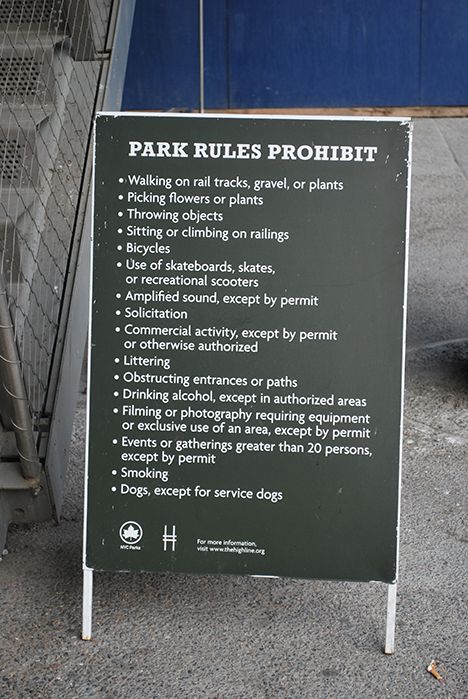
The list of “don’ts.” 10.14.13.
Given the preponderance of dogs throughout the streetscape of New York City, it seems doubtful that the potential damage would be so great. However, the sheer numbers of people using the High Line at peak periods is perhaps enough justification to exclude their dogs. They would contribute to even more congestion.
It is interesting to contrast these restrictions to those in use at the former abandoned railroad track Promenade Plantée (French for tree-lined walkway, it is now known as the Coulée verte René-Dumont) in Paris, one of the designs which provided inspiration for the High Line. Most of the above restrictions are not in effect. On my one visit there in July 2009, I saw bicyclists, roller bladers, joggers with dogs, and so on. On a cloudy day, the whole elevated portion was well-used, if not crowded as the High Line often is.
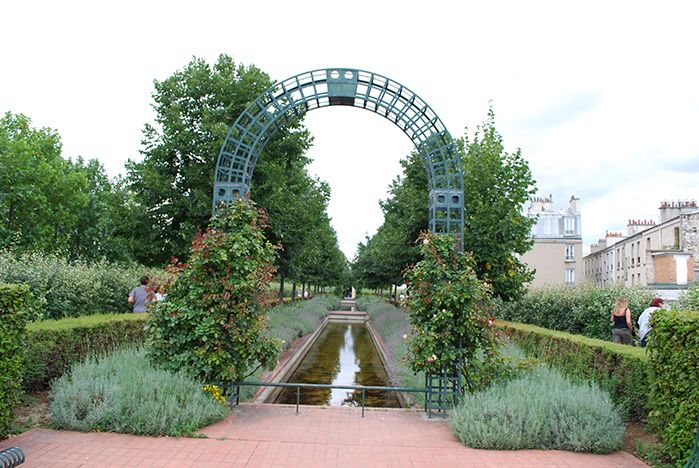
French for tree-lined walkway, the Promenade Plantée often screens views of the city in contrast to the High Line which often brings visitors right to the edge of the trestle. 7.18.09.
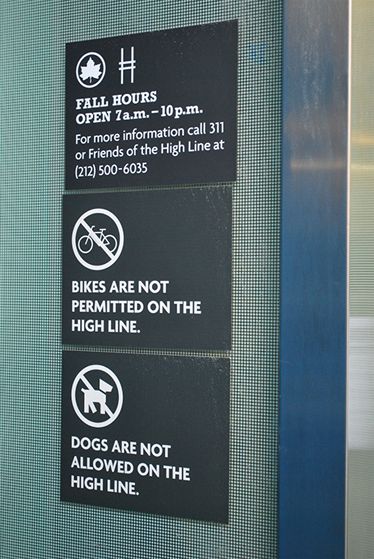
Signage on the High Line adjacent to an elevator. 11.30.13.
It perhaps should be mentioned that Europeans, and Parisians in particular, have a much more lax attitude than Americans when it concerns dogs in public places, cigarettes, and acceptable limits of public behavior. Even so, the Promenade Plantée has a general atmosphere of cooperative interaction; people acknowledge one another and also mind their own business.
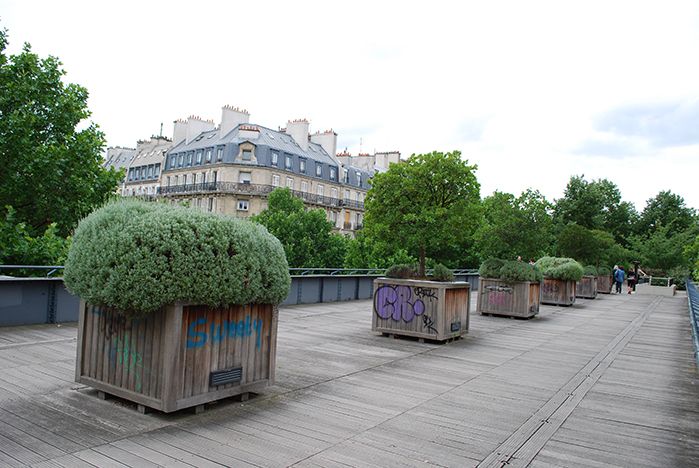
Graffiti have proliferated on the Promenade Plantée as both park usage and maintenance funds have both decreased; 7.18.09.
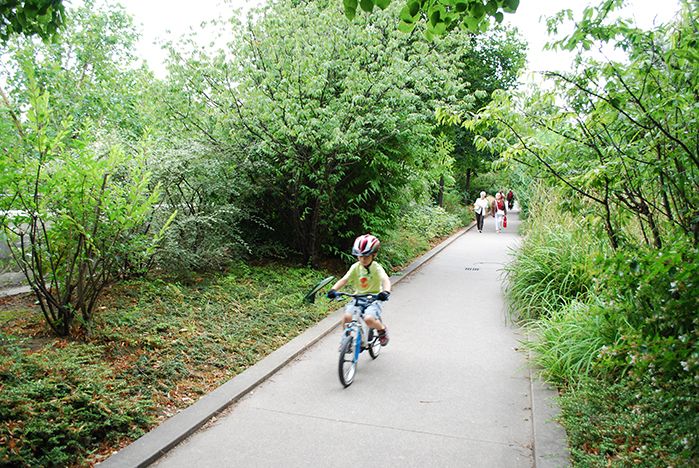
The Promenade Plantée features a much simpler walk system than the High Line so it can readily accommodate bicyclists, roller skaters and dogs, all forbidden on the High Line. 7.18.09.
Part 11 – Sustainability Discussion
For the discussion on sustainability, a working definition of sustainable design is “design that nurtures itself, that uses and recycles all materials and systems so there is no net loss to the environment as a result of implementing the design, and that, once completed, functions without a net drag on the resources and systems on which it depends.”[10] Although this definition is general, a researcher could take a practical, nuts-and-bolts approach, and calculate footprints of different areas of the High Line and compare the inputs and outputs of energy and resources. That is more than I have time for here.
Certainly, different elements of the High Line have been carefully designed and refined to conserve energy and resources; nevertheless, it’s a challenge to conceive of the entire park as a sustainable design. The designers deserve credit that there are many individual elements and aspects of the park which are consistent with sustainable design principles, yet the park as it now operates, particularly in its maintenance operations and food vending services, seems based on different criteria.
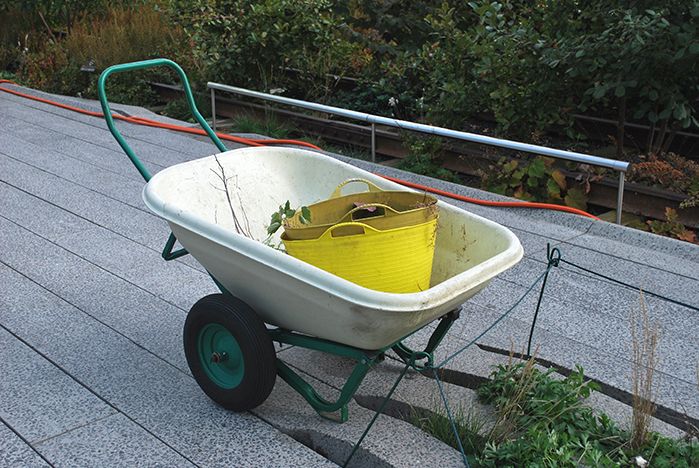
10.14.13.
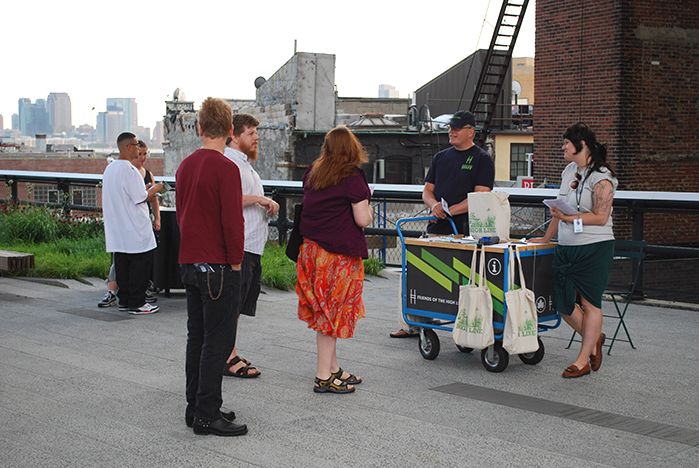
6.15.10.
On the plus side, on the High Line’s plank-walk system there is an 80% reduction of runoff since water drains into the open joints between the concrete planks and is absorbed into the planting beds.[11] This is an important water conservation measure as the plantings receive additional water and reduce irrigation demands, and the volume of storm runoff that flows into the city storm sewer system is greatly reduced.
Many of the plant materials were purchased from growers in the greater metropolitan region, thereby limiting fuel and transportation costs. Such plants are more adaptable then those brought in from different climates at greater distances.
The green roof technology on which the design is based has standard, now well-publicized advantages: just a few are reduction of the heat island effect, the aforementioned reduction in storm water runoff, and a community of plants that provide habitats for birds and insects.
According to the High Line website, its living roof system is set atop the waterproofed concrete of the structure itself and is made of the following layers:
- A perforated black plastic “egg-crate” drainage panel to provide water retention, drainage, and aeration to the soil
- A layer of crushed pea-gravel to act as a buffer, regulating the speed at which water drains
- Woven filter fabric to keeps soil particles from clogging the drains
- A layer of coarser, clay-based subsoil
- A layer of finer, more nutrient-rich topsoil
- A top layer of gravel mulch to aid in water retention and prevent soil erosion due to wind. [12]
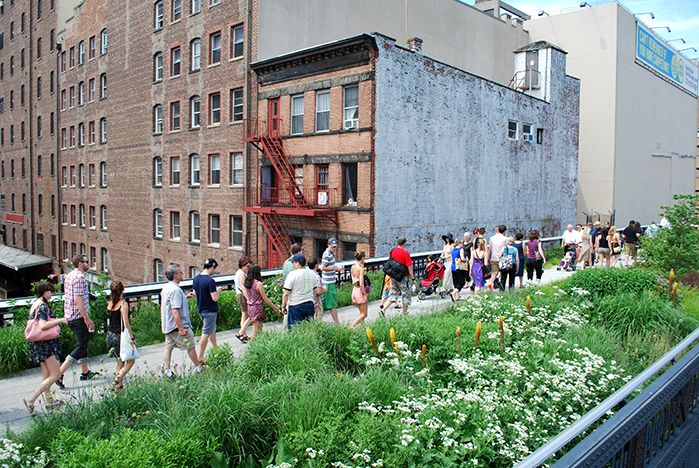
“Autumn on the Hudson Valley with Branches” was removed with the opening of Phase Two; 6.19.11.
The LED system in the trestle handrails uses much less electricity than conventional lighting, and the water feature as fully engineered includes a closed circulation system to reduce water usage. The High Line does not use chemical fertilizers or pesticides, and uses Green Seal certified cleaning products. A composting system is being set up so that the High Line can recycle garden waste.
Yet some of the design decisions made are perhaps contrary to a common sense approach to sustainability. For example, it is difficult to verify harvesting practices of ipe and teak from sustainable forests at great distances overseas, and shipping and transportation costs are exorbitant. It is commendable that the High Line specified alternate materials in the second phase.
As previously noted, the runoff from the drinking fountains also drains into the planting beds. The water sheet flowing over pavement in the water feature is recirculated. But it’s unfortunate that both elements cannot be operational year round since New York City’s urban heat island climate accommodates so many visitors during the winter. If one needs a drink of water along the route in the winter months, the only options are to buy a drink from a food vendor or take one of many routes down to the street to restaurants, hotels or other facilities that might offer such amenities.
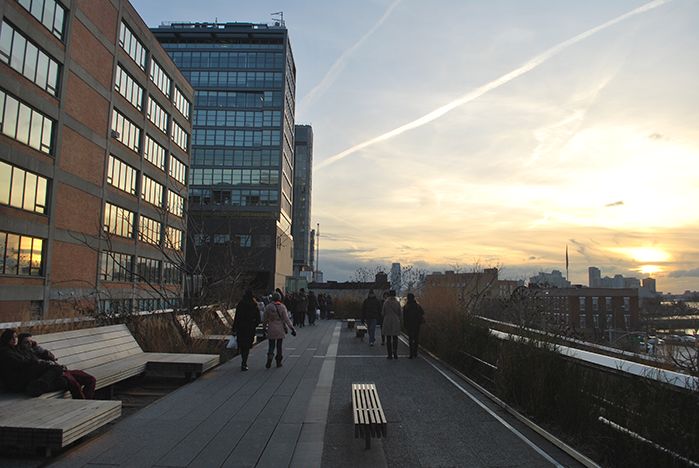
11.30.13.
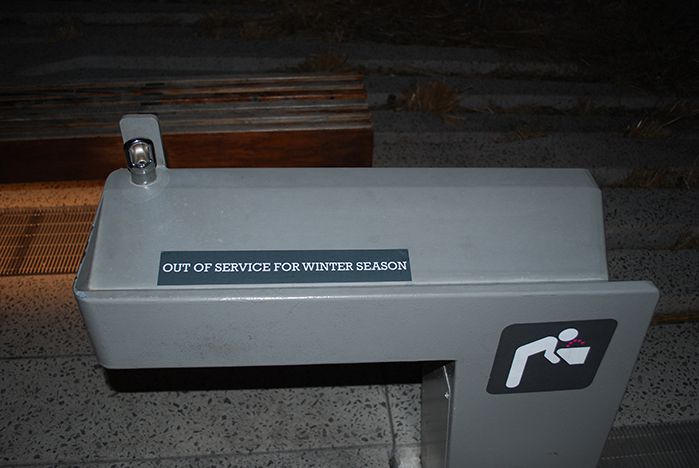
2.18.12.
As previously pointed out, some elements of the High Line, such as the water feature and the pavement systems, keep being further refined after their initial design installation. When there is almost an unlimited budget for revisions to design details and changes to materials, it is nevertheless hard to conceive of the public art installations, the diverse array of lighting fixtures and manufacturers, the proliferation of food stands and the large number of park employees as being consistent with the spirit of sustainability so carefully and thoughtfully incorporated into much of the project, because all of these additional amenities, systems and personnel add considerably to the cost of operations and maintenance.
The maintenance cost of the High Line is by far the highest of any part within New York City, as I wrote about in Part 8, the Maintenance & Irrigation Discussion of 5/14/14, yet it’s a unique installation. Higher costs do not always equal less sustainability. Since the use if the park is so high, perhaps the cost of maintenance per person/ or user could be very low. Public spaces need maintenance for their own sake as well as the health and safety of their visitors. The bigger the project, generally the higher the costs, but if it was designed sustainably, should the costs be lower than average? To some degree, the design itself and the nature of the corrective actions taken, and the intensive maintenance required all contribute to the cost.
The numerous public art installations, often quite attractive, require people to slow down to observe and engage the art, thereby adding to congestion on the walks. This problem is most challenging in those locations where the art is displayed within the planting beds, and there is not a step-out, as standardly occurs within the integral bench designs, for pedestrians to pause and reflect. At peak use periods pedestrian traffic jams occur frequently. Since most of the public art is temporary, there are significant costs and impacts for removal of existing works and installation of new ones. It might be prudent to limit the settings for art works to wider locations in the pavements or gathering points in the route and avoid placing sculptures in the middle of plantings which could easily be damaged during these operations.
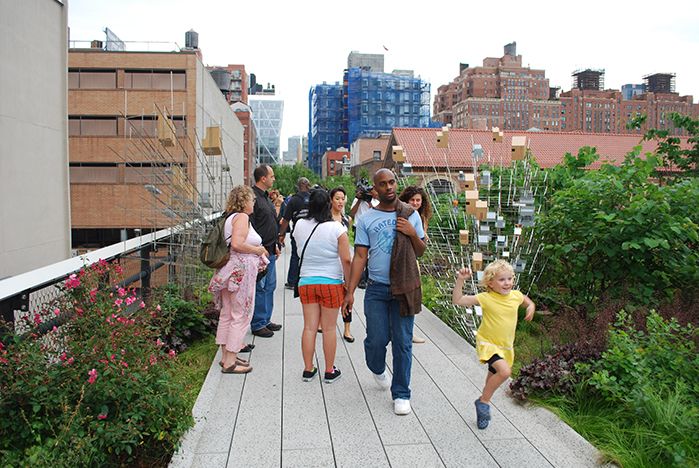
Sarah Sze’s Still Life with Landscape – Model for a Habitat was a stainless steel sculpture that included boxes for birds’ nests set on either side of the walk; 6.10.11.
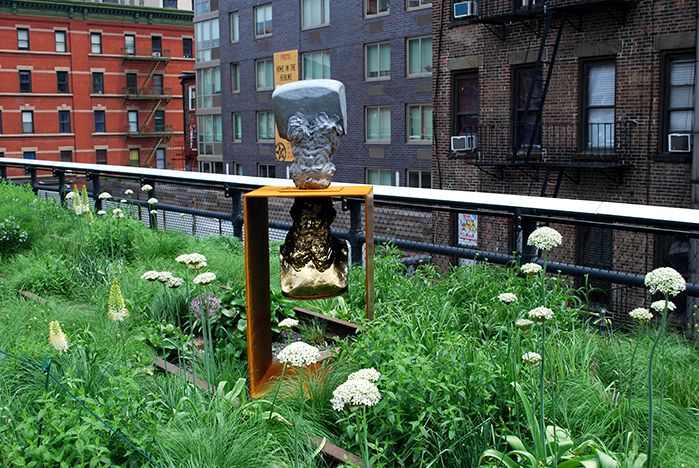
Steven Claydon’s UNLIMITEDS & LIMITERS; 5.29.13.
Perhaps, this issue underscores a basic question: What is the most important aspect of the design of the High Line to maintain at a high level? I would argue that the plantings are. On the one hand, there are elements that incorporate sustainable design practices, such as the drinking fountains whose runoff drains into the planting beds; on the other, there are many others, such as the art installations and food services, which require large expenditures of resources and staff.
How is a balance to be achieved? The more that programmed activities and outside services are incorporated into the High Line, the more potential there is to overtax the other systems, and mar enjoyment of the views of the city and the plantings. As the High Line continues to evolve, it’s worth asking what uses and activities are most important to guarantee a permanent life span for this park.
A far-reaching definition of sustainable design is the concept of “restorative environmental design” as defined by the (late) social ecologist Stephen R. Kellert, who has developed the concept of a restorative environmental design that enriches the human spirit by creative connections between nature and the built environment.
He explains: “Restorative environmental design avoids and minimize harmful impacts on the natural environment and human health, while also providing positive opportunities for beneficial contact with nature in places of cultural and ecological significance. The major difference from conventional approaches to sustainable design is the tendency to focus on the first part of the definition (minimizing harmful environmental impacts) while ignoring the inherent human need to affiliate with natural systems, referred to as biophilia by myself and colleagues.”
NOTE – Cantor, Steven L. Green Roofs in Sustainable Landscape Design. New York, NY: WW Norton Inc. 2008, p.34; Kellert, Stephen R. Building for Life: Designing and Understanding the Human-Nature Connection. Washington, DC.: Island press, 2005
In this context, one of the strongest elements in the High Line is the water feature at the Diller – von Furstenberg Sundeck as sunbathers on the large chaise lounge-like benches as well as pedestrians wetting their feet in the sheet of moving water find their view drawn to the dramatic image of the Hudson River flowing along the edge of Manhattan. By experiencing the High Line’s interpretation of nature, people sense a strong connection to one of the vast natural systems of New York City, a remarkable design achievement.
On the other hand, nowhere on the High Line or for that matter, anywhere in Chelsea, is there any attempt to remind or educate visitors that they are in a flood zone. The storm surge from Hurricane/Storm Sandy flooded lower Manhattan as far north as Chelsea. The High Line is safely 30 feet above street level, but the 23rd Street elevator was severely damaged and took many months to repair.
It would be helpful and appropriate for the High Line to incorporate some interpretive elements to explain the neighborhood’s susceptibility to future storms and emphasize that despite its soaring and vibrant presence above the street network of Manhattan, it’s deeply rooted to the infrastructure below.
Additional High Line Restrictions and User Activities & Sustainability Photos
That’s it for now. I hope that these different sections of text and images of the High Line will generate discussion.
Come back next time for Part 12, Studies/Research Discussion of “A Comparison of the Three Phases of the High Line, New York City: A Landscape Architect and Photographer’s Perspective.”
Steven L. Cantor
Photos © Steven L. Cantor are available for individual purchase.
Cumulative 14-part “A Comparison of the Three Phases of the High Line, New York City: A Landscape Architect and Photographer’s Perspective” Series End-notes
1. Ulam, Alex. “Back on Track,” Landscape Architecture Magazine. Volume 99, No. 10, October, 2009, p. 97.
2. http://www.thehighline.org/news/2012/01/24/major-milestone-for-the-high-line-at-the-rail-yards
3. http://www.thehighline.org/sustainability
4. http://www.thehighline.org/design/planting
5. Ulam, Alex. “Back on Track,” Landscape Architecture Magazine. Volume 99, No. 10, October, 2009, p. 97 and 105-106. He refers to an article in the New York Post.
6. David, Joshua, Reclaiming the High Line, a project of the Design Trust for Public Space with Friends of the High Line. Karen Hock, editor, (New York, Ivy Hill Corporation and others, 2002). p.7.
7. http://www.thehighline.org/about/ask-a-gardener
8. http://untappedcities.com/2013/10/17/live-blog-from-2013-mas-summit-for-nyc-day-1/
http://untappedcities.com/2012/04/26/partners-in-preservation-the-high-line-section-3/
http://untappedcities.com/2013/11/13/spur-the-third-section-of-the-high-lines-crown-jewel-a-nest-in-the-sky/ (by Bhushan Mondkar)
9. http://www.thehighline.org/sustainability and http://www.thehighline.org/about/faq
10. http://www.thehighline.org/about/faq
11. Cantor, Steven. Green Roofs in Sustainable Landscape Design. (New York, WW Norton, 2008). p. 34 (Several additional definitions are provided. It is possible to measure sustainable elements precisely, from carbon footprints to other calculations, but that is beyond the scope of this discussion.)
12. http://www.thehighline.org/sustainability
Publisher’s Note:
See Steven L. Cantor’s ENTIRE 14-part “A Comparison of the Three Phases of the High Line, New York City: A Landscape Architect and Photographer’s Perspective” Series.
Steven L. Cantor, Landscape Architect
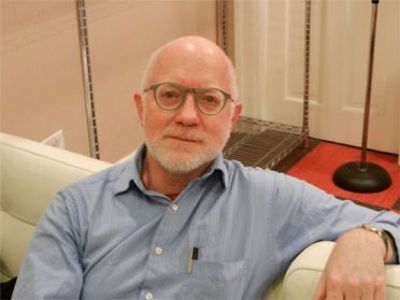
Photo by Thomas Riis.
Steven L. Cantor is a registered Landscape Architect in New York and Georgia with a Master’s degree in Landscape Architecture from the University of Massachusetts, Amherst. He first became interested in landscape architecture while earning a BA at Columbia College (NYC) as a music major. He was a professor at the School of Environmental Design, University of Georgia, Athens, teaching a range of courses in design and construction in both the undergraduate and graduate programs. During a period when he earned a Master’s Degree in Piano in accompanying, he was also a visiting professor at the College of Environmental Design at the University of Colorado, Boulder. He has also taught periodically at the New York Botanical Garden (Bronx) and was a visiting professor at Anhalt University, Bernberg, Germany.
He has worked for over three decades in private practice with firms in Atlanta, GA and New York City, NY, on a diverse range of private development and public works projects throughout the eastern United States: parks, streetscapes, historic preservation applications, residential estates, public housing, industrial parks, environmental impact assessment, parkways, cemeteries, roof gardens, institutions, playgrounds, and many others.
Steven has written widely about landscape architecture practice, including two books that survey projects: Innovative Design Solutions in Landscape Architecture and Contemporary Trends in Landscape Architecture (Van Nostrand Reinhold, John Wiley & Sons, 1997). His book Green Roofs in Sustainable Landscape Design (WW Norton, 2008), provides definitions of the types of green roofs and sustainable design, studies European models, and focuses on detailed case studies of diverse green roof projects throughout North America. In 2010 the green roofs book was one of thirty-five nominees for the 11th annual literature award by the international membership of The Council on Botanical & Horticultural Libraries for its “outstanding contribution to the literature of horticulture or botany.”
Steven’s most recent book is Professional and Practical Considerations for Landscape Design (Oxford University Press, 2020) where he explains the field of landscape architecture, outlining with authority how to turn drawings of designs into creative, purposeful, and striking landscapes and landforms in today’s world.
He has been a regular attendee and contributor at various ASLA, green roofs and other conferences in landscape architecture topics.
In recent years Steven has had more time for music activities, as a solo pianist and accompanist. In 2011 he performed a solo piano program at the Winter Rhythms festival at Urban Stages Theater. He’s a regular performer at musicales hosted in Chelsea and other settings in Manhattan. On August 25, 2013, Leonard Bernstein’s birthday, he performed with Stephen Kennedy Murphy a program of excerpts from the composer’s MASS and Anniversaries.
Steven joined the Greenroofs.com editorial team in December, 2013 as the Landscape Editor. In February, 2015 he completed his 14-part series “A Comparison of the Three Phases of the High Line, New York City: A Landscape Architect and Photographer’s Perspective.”
 Greenroofs.comConnecting the Planet + Living Architecture
Greenroofs.comConnecting the Planet + Living Architecture
